Old Cattle Market /
St
Stephen's Church & Lane / Sir Thomas Rush: his chapel and house
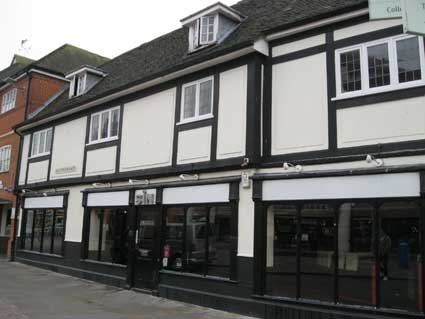
The building in which we're particularly interested is
the
former Blue Coat Boy public house which we mentioned on our More Schools
page in relation to the school sign (now gone) in Curriers Lane.
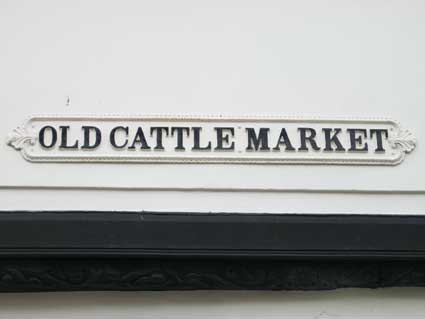

The metal street sign is a decorative variant on the more heavy-set
cast iron street name signs featured on our Street
Signs page. The six screw heads which attach it to the rendered
wall are picked out in black paint and the curving ogee-type frame has
a sideways fleur-de-lys extending at each side. The satisfyingly
serif'd caps of the name proclaim that 'The Old Cattle Market'
extends to this open area at the top of Silent Street and is not just
the area we now call the bus station.
'The Blue Coat Boy'
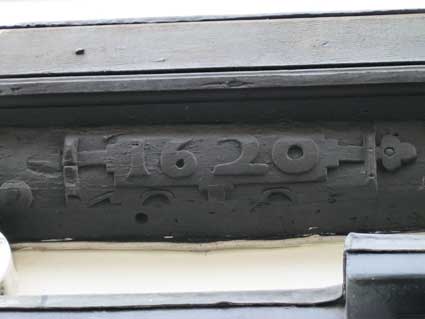 2014 images
2014 images
However, the real revelation on this building is tucked under the small
jettied overhang of the first floor. '1620'
which is carved into the
(very narrow) black-stained bressummer beam is a surprise, particularly
as it's so well hidden. Our only worry about the
beam is that it's in
such surprisingly good nick for a 17th century piece of carving; we
suppose that it could be a reproduction installed during one of the
facelifts that these old buildings were often subjected to. However,
the date could well be accurate and it's nice that it still
exists. Thanks to Ken Nichols for the tip-off about this dated
beam. See also the building at the end of Fore
Street which bears a bressummer with the same date.
It's worth comparing with the (also) rather recent-looking '1636' date
on a
building in St
Helen's Street (near Major's Corner), the rather more weathered
'1631' date on the bressummer beams on the Captain's Houses in Grimwade
Street which can be found on the the the Isaac Lord page which is also dated '1636'.
Where once crowds
gathered to witness martyrs being burned at the stake and bulls being
baited, cattle were bought and sold on the Cornhill. The Cattle Market in Ipswich has been pushed to several
locations
as the town expanded and became more crowded, particularly after the
movements of the cavalry through the town started once the barracks
were opened close to Barrack Corner on Norwich Road. The Provision
Market moved from the Cornhill to a one acre site (formerly the house
and grounds of Major Heron) lying between Market Lane - after which it
was named - and St Stephens Lane and opened on Saturday 22 December
1810. You can still see the 'stub' - to use a Wikipedia term - of
Market Street coming off the south side of the thoroughfare called
Buttermarket at the back of the building now housing a coffee
chain, formerly one of several buildings there owned by the firm W.S.
Cowell which combined the businesses of fine printing & stationery,
wine & spirit merchants, tea, coffee and spice merchants, rag
recycling (into printing paper) and home furnishing. The company was
started by Walter Samual Cowell in the Buttermarket in 1818 and after a
long and, towards the end chequered history, this famous firm came to
an end in 1992. The lower end of Market Street, which used to come out
into Falcon Street was cut off by the Buttermarket Shopping Centre in
1986.
When a bigger
location had to be found for the Cattle Market, the owners of the
Provision Market purchased a third of an acre site and added a low wall
and railings, it had a gate onto the top of Silent Street. The site was
not ideal as it was surrounded by a spider's web of small lanes: Dog's
Head Lane was only 15 feet between house frontages. Buying and selling
of livestock
continued on the site we still call 'Old Cattle Market' until 1856 when
the market was moved to the marshy ground near Friars Bridge: you can
still see Friars Bridge Road coming off the north side of the stretch
of Princes Street, close to the Greyfriars roundabout. The land level
was raised about six feet above the surrounding marsh and the Cattle
Market reopened there in September 1856. It continued in operation on
the site until 1986, when a car park was built there. Plus ca change...
See Reading List for Muriel Clegg's 'The way
we went', used for information above.
To the left of the older buildings is a modern structure: Coachman's
Court, the horse-drawn mean of transport once so central to the town's
economy commemorated on the entrance plaque and on the weather vane
high
(and wonky) above.

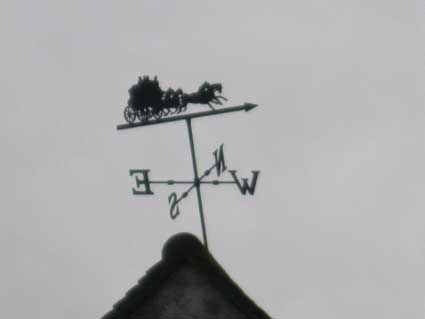 2014 images
2014 images
Standing with your back to Silent Street, you can spot another OCM
street sign, easy to miss tucked under an overhang of the Buttermarket
Shopping Centre building.
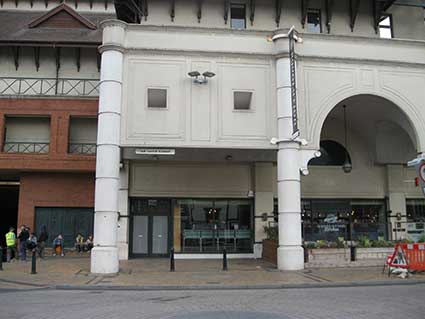
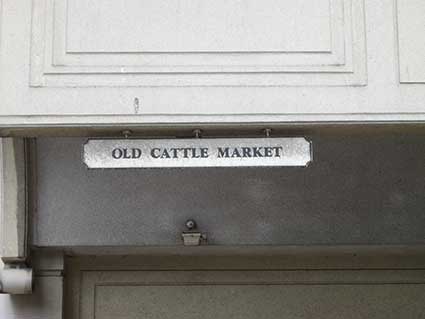 2016 images
2016 images
Sir Thomas Rush and the Church of
St Stephen,
St Stephens Lane
Incidentally, the Church of St Stephen is well
worth a visit now that
it is frequently open as a Tourist Information Centre. This lettered
sheet of lead and its information plaque are displayed in the interior:-
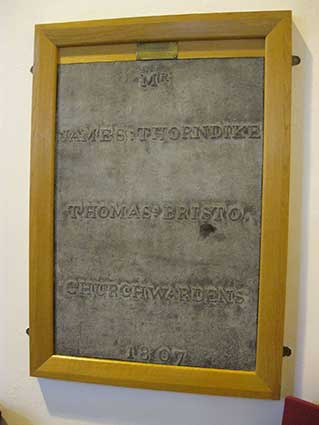
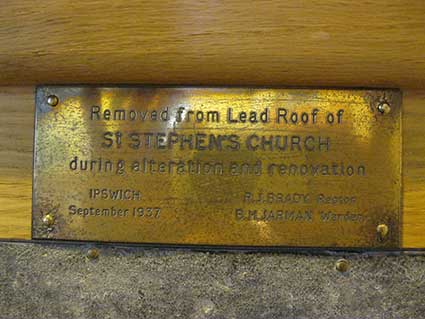
'MR:
JAMES : THORNDYKE
THOMAS : BRISTO,
CHURCHWARDENS
1807'
'Removed from Lead Roof of St STEPHEN'S CHURCH during alteration and
renovation
IPSWICH, September
1937 R.J.
Brady, Rector B.H. Jarman Warden'
Reading: Blatchly, J. Ipswich Tourist Information Centre in the
medieval Church of St Stephen's, Ipswich (see Reading list) is a short, attractive booklet
sold for a pound at our TIC.
See also St Margaret's Church
which carries a similar style – if rather
more chunky – 'T' on a buttress. It is only a few steps
away from here that we find The Sun Inn
(formerly Atfield & Daughter).
The Rush bressumer beam
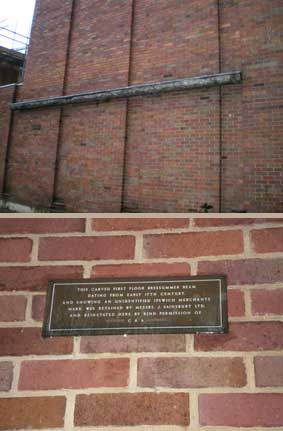
After the '1620' beam seen in Old Cattle market, another carved
bressumer hangs rather incongruously on the back of
Wilkinson's modern block, facing the east end of the Church of St
Stephen. There
is a small plaque below it which tells
us a little:
'This carved first floor bressummer beam dating from early 17th***
century, and showing an unidentified merchants mark, was retained
by Messrs. J. Sainsbury Ltd. and reinstated here by kind permission
of C&A'. [... the new stores opened in 1971]
The clothing store C&A has long gone from this building,
currently occupied by Wilkinson hardware; Sainsbury occupies the next
shop south of Wilkinson on Upper Brook Street, with a partial frontage
on Dog's Head
Street). Where the bressumer came from isn't recorded on the
plaque,
but it is thought that Rush’s house was located on the place
where the supermarket now stands. The first
shield about a third of the way in from the
left with the 'V' shape is said to be the coat
of arms of the Rush family (however, it is probably Rush's badge as
serjeant-at-arms to the king). The merchant's mark on a
shield beside it is a vertical with
arrow heads at each end and an 'X' at its centre.
The letter 'R' is on a corresponding shield about a third of the way in
from the right. The royal crown is crved at a central position on the
beam. The remaining carving shows
mythical beasts.
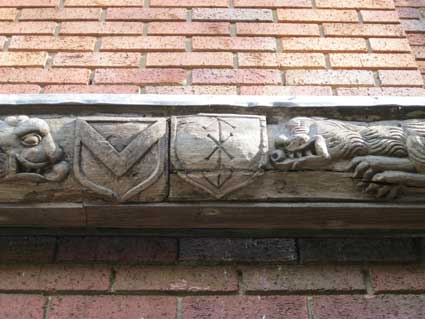
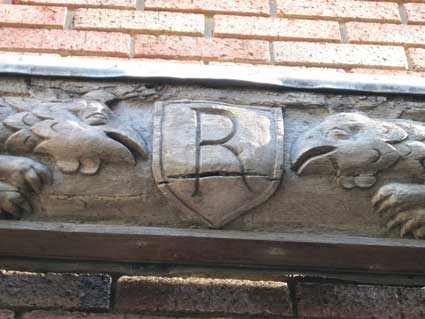
Here are the two halves of the bressumer with the central royal crown
shown on both. Scroll down for the bressumer in place on the Underwoods
shop in the 1960s.
 2016 images
2016 images
Ken Nichols has supplied this information:
"You requested more information about the 'R' on the beam near St
Stephen's. It is the R of Thomas Rush [or Russhe] 1487-1537 who apart
from being an important man in the town and country funded the
rebuilding (I believe the south area) of St Stephen's Church. There is
also a 'T' for Thomas on the south side (or doorway) I need to check
where, I gained these notes from a town guide."
Another source is Ryan Rush's blog about his ancestor:
"In 1490, Thomas Rush was born in Sudbourne, Suffolk, England. He
gained favour with the Tudor monarchy, first with King Henry VII and
later with his son Henry VIII, who knighted him in 1533 at the
coronation of Anne Boleyn [the year before he was made sheriff of
Norfolk and Suffolk.]. He married Anne Rivers of Ipswich. In 1543
Sir Thomas became the father of another Thomas. This Thomas
served briefly in the House of Commons."
[***Note that Thomas Rush's lifespan of 1487-1537 gives the lie to the
date of "early 17th century" on the beam's information plaque, given
that the bressumer came from Rush's Ipswich house.]
Thomas Rush was a friend of Cardinal Wolsey (c.1475-1530; Henry VIII's
first Lord
Chancellor and Ipswich's most famous son). Rush survived the fallout
from
Wolsey's downfall and attached himself to Wolsey's successor, Thomas
Cromwell. Sir Thomas Rush is interred in the nearby Church of St. Stephen in Ipswich,
which is now the Tourist Information Centre and art gallery. Sir
Thomas' most famous name-bearing descendant is Dr Benjamin Rush,
signer of the United States Declaration of Independence in 1776. Dr
Rush is Sir Thomas' descendant through the latter's eponymous son.
[UPDATE 27.2.2012: Eventually,
in early 2012, we solved the problem of the missing 'T' of 'Thomas
Rush'. It took two visits to St Stephen's Church, two good walks
round the exterior and one round the interior, consultation with the
Tourist Information officer inside, reading of a free sheet on the
church and a 'phone call from within to one of their local history
experts. It is now clear that the wealthy and important Sir Thomas Rush
endowed the church in order that a chapel be built on the south side of
the nave dedicated to him. Looking at the exterior south wall of the
church seems initially unpromising until one realises that the third
buttress down the wall from the 'Wilkinson end' is rather wide and
contains an arch.

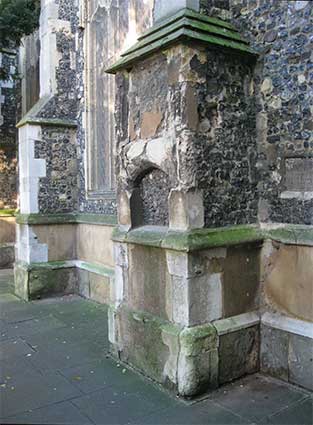
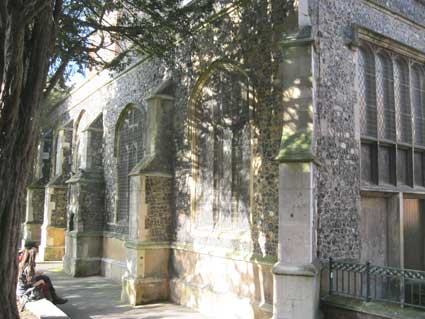
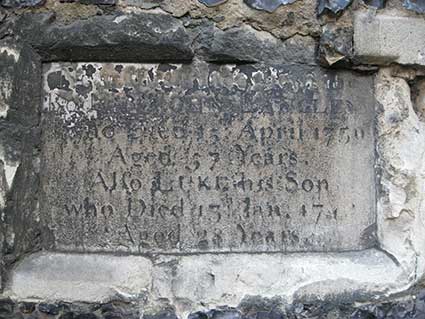
Above: to the right of the large buttress is a memorial plaque:
'[Near to this
spot lies the]
Body of JOHN LANGLEY
who Died 15 April 1750
Aged 57 Years.
Also LUKE his Son
who Died 13 Jan. 1742[?]
Aged 28 Years.'
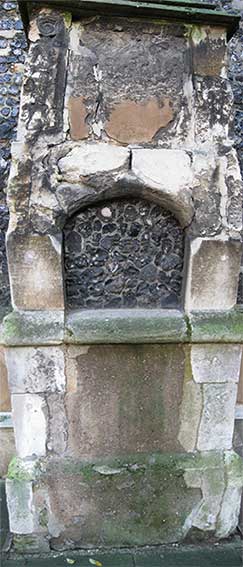 Composite
2016 photograph of the buttress
Composite
2016 photograph of the buttress
The area of interest is above the small blocked arch where a Rush
family crest borne by two angels carved in stone
was once in place in the masonry. The initials
'T' to the upper left and 'R' to the upper right commemorated the
donor; the 'R' is long gone as is the crest. However, if you look
carefully there is a curly initial 'T', roughly
similar to that used on a well-known daily newspaper masthead: 
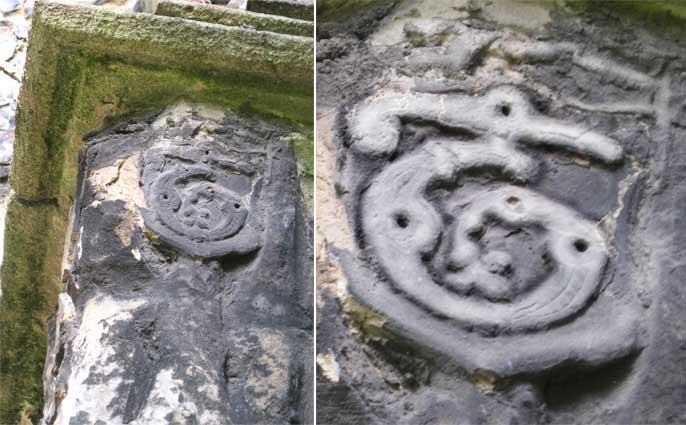
The letterform is one form of the Lombardic
alphabet
and these examples show variants: carved in stone and calligraphically:

Our image includes an enhancement to show
the decorative
character 'T' with hints at the shield shape which seems to have
surrounded it.* There are traces of the decorative scoring which was
incised into the letter. We learn that the blocked arch was a tiny
doorway through the centre of this wider-than-normal buttress; it gave
access to the private chapel. Clearly, they built people much smaller
in those days.]
*See also the Church of St Margaret
for the use of two Lombardic characters in the fabric of the church:
'T' and 'M'.
[UPDATE 19.3.2020: metal
barriers have been erected on this site; one wonders if the once-mooted
sympathetic refurbishment of this buttress is going ahead? The
stonework is certainly cleaner than shown in the 2016 photographs.]
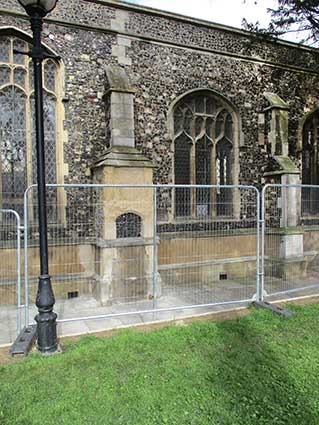
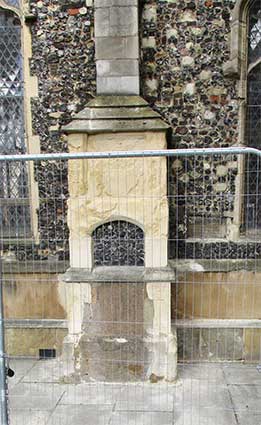 2020
images
2020
images
Once the barriers have been cleared away, we can take a closer look at
the cleaning. The surface does appear to have been scoured. It's
difficult to make out whether the Lombardic 'T' at top left is as crisp
as it was when covered in grime.
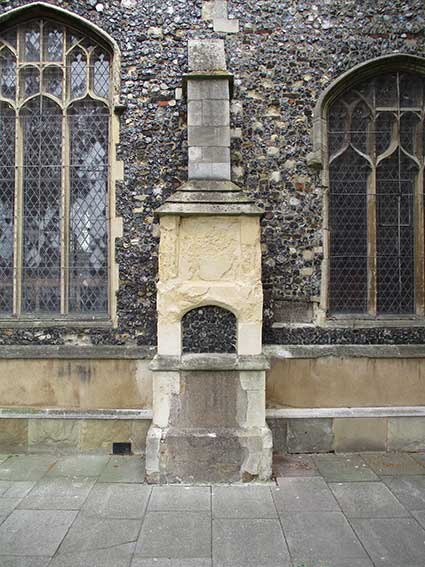
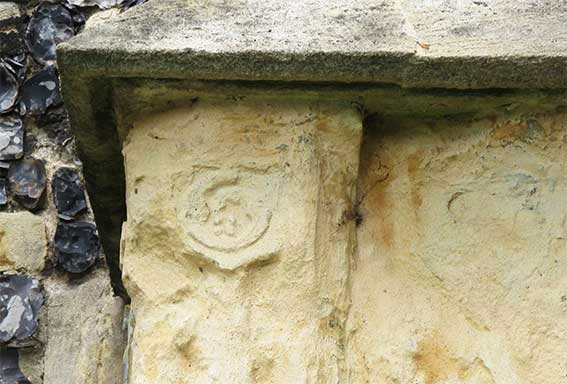 2021
images
2021
images
Sir Thomas Rush and Thomas Alvard
Robert Malster in A history of
Ipswich (see Reading list) tells us
more of Sir Thomas Rush and Thomas Alvard following the dissolution of
the monasteries ordered (taking a leaf out of his
former
Chancellor, Wolsey’s book) by Henry VIII.
‘That there were such rich pickings to be had is shown by the fact that
in 1535 the clear temporal income of the Priory of Holy Trinity was
over £69 and-a-half, spiritual over £18 and-a-half, giving a total of
over £88. Primarily the pickings went to the Crown, but there were
others able to pick up a bargain on the way. Two men who benefited from
the events in Ipswich were Sir Thomas Rush and his stepson and
son-in-law Thamas Alvard (Rush married the widow of Thomas Alvard the
elder, Thomas’s mother, and young Thomas married Rush’s daughter by an
earlier marriage). Rush had been made the king’s [Henry VII’s]
serjeant-at-arms in 1508 and continued in the king’s service until
1530s; it may have his familiarity with the court which introduced his
stepson to the service of Cardinal Wolsey at the time he was setting up
his college in Ipswich. The friendship of Wolsey’s servant, Thomas
Crowell, proved an invaluable investment, for when Wolsey fell Alvard
followed Cromwell into the king’s service.
‘Having served as attorney for the college with his nephew William
Bamburgh, Rush was able to offer his inside knowledge of Wolsey’s
affairs to the royal administration; and Alvard was able to do the
same. In doing so they were able to pick up some of the spoils.’ Rush
was on the county commission to enquire into Wolsey's late lands in
1530, and both he and Alvard did well out of the Crown leases in this
property.
Thomas Rush was also elected to represent Ipswich in parliament in
1523. In 1534 Rush and Alvard were elected as joint
representatives of Ipswich to Westminster. Alavard died the next
year and Rush two years later.
Rush and Alvard were canny political survivors and they certainly had
an eye to business. When, after the Cardinal's fall, Wolsey’s college was closed down
and the fabric dismantled and stockpiled on the site, it was
appropriated by the king. Much of it was transported to Westminster (to
be used on the building of Whitehall
Palace?). Some idea
of the scale of the college campus can be guaged from the fact that the
Exchequer accounts of 1531 record 1,300 tons of Caen stone (initially
imported from Normandy – Ipswich doesn’t have local supplies of stone)
and 600 tons of flints (initially brought to Ipswich from the cliffs in
Harwich).
The southern chapel at St Stephen should more correctly be called the
Rush-Alvard Chapel (see the link below to the paper by Blatchly and
MacCulloch). Ogilby's map of 1674 features illustrations of the
medieval churches in Ipswich including this church, with the doorway
through the central buttress clearly shown:
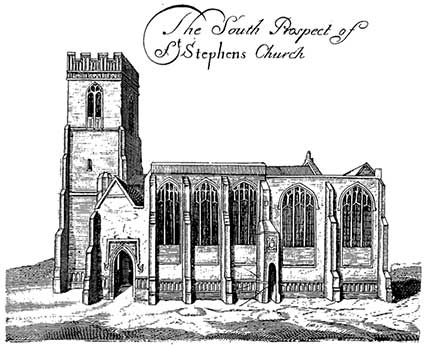 1674 view
1674 view
Interior
St Stephen has a painted royal arms of Charles II
inside the church. It features, below the royal crest, two small
figures
who reappear in the arms on The Ancient
House, the Church of St Margaret
and the Church of St Clement. For more discussion on this, see our Church of St Clement page under 'The royal arms of
Charles II: who are these people?'.
Sir
Thomas Rush's house,
Upper Brook Street
Further research turned up a learned paper by Diarmaid MacCulloch and
Dr John Blatchly published by The Suffolk Institute of Archaeology and
History: 'Recent
discoveries at St Stephen's Church, Ipswich, the Wimbill Chancel and
the Rush-Alvard Chapel'. This splendid piece of work encompasses
all the elements mentioned above and more.
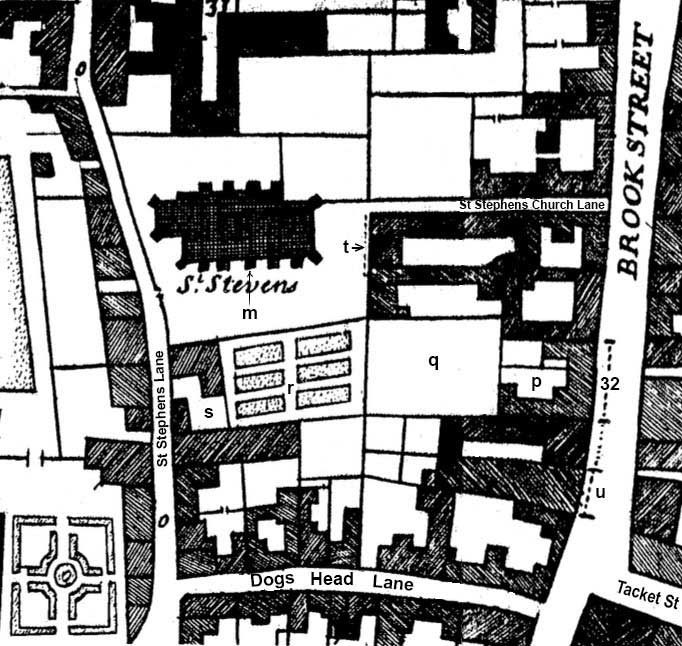 1674 map
1674 map
'Using a modified section of Ogilby's map of 1674
(Fig. 22) it
is now possible to show the extent of the Rush premises. The
property (p)
became 32 Upper Brook St., and both Haslewood and Woolnough, who were
able to examine the buildings in the 1930s, suggested
that one or two adjoining properties to the south were once part of the
same building. The carved bressumer was formerly on No. 40 (u),
and it is entirely reasonable that the Rush frontage ran the whole
distance represented by the dotted line. The indenture of 1518 by which
Rush leased the parsonage garden from the incumbent for 99 years at an
annual rent of 4 shillings defines the plot precisely as (r) adjoining Rush's garden (q) to the east and the
parsonage itself (s)
on the west. William Neve, wheelwright, was the occupier to the south.
From his extended grounds Rush could then survey the entire south side
of the church to which he was to add so much. It is appropriate, though
coincidental, that today his bressumer at (t) overlooks the family chapel
[buttress entrance arrowed m],
and that each bears one initial to make up T.R.'
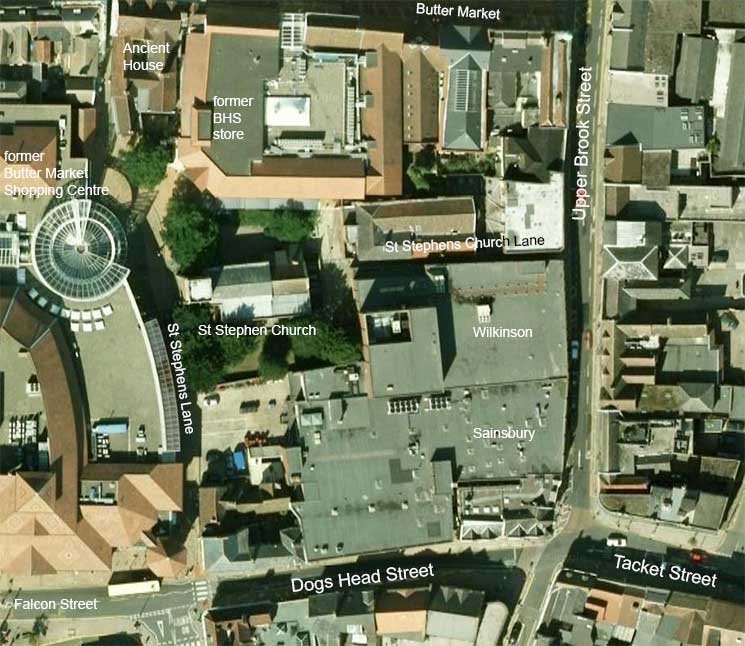 2015 aerial view
2015 aerial view
Below: overlaying up
the 1674 map onto today's aerial view (and lining up the church and St
Stephens Chuch Lane) shows clearly that the Rush bressumer was sited on
a section of the old Ipswich Building Society offices (u) – quite surprisingly close
to the Tacket Street junction. It is clear also that the line of Dogs
Head Street has been altered over the centuries. The potential
frontage of
Rush's house (from u
up to p)
covers the footprint of all of today's Sainsbury's store.

See also our Withypolls
memorials page for Sir Thoma Rush's role (along with his neighbour,
Sir Humphrey Wingfield) in the sale of the
Holy Trinity Priory site and the early days of Christchurch Mansion.
Underwood's shop
'It was in 1970 that all the buildings on the west side of the
street from St Stephen's Church Lane southward (Nos. 28 to 40) were
demolished, and the present C. & A. and Sainsburys premises were
built on the site. Only the elaborately carved bressumer beam from the
street front of No. 40 (next door but one to No. 32) was saved; it is
now mounted on the west wall of C. & A. facing the east end of St
Stephen's church (Fig. 21). The beam has on it three shields which
carry, separately, a merchant's mark, a chevron, and a letter R, also a
Royal crown with dragon and lion supporters. There are winged beasts,
probably gryphons, on either side of the R. Rush's badge as
serjeant-at-arms to the King would have been the Royal crown, and that
and the R on the beam point to him.' (MacCulloch &
Blatchly)
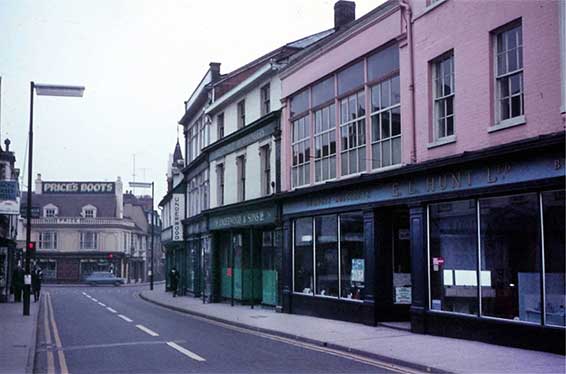 Courtesy Ipswich Society Image Archive
Courtesy Ipswich Society Image Archive
Above: the shops now occupied by Sainsbury and Wilkinson in the 1960s.
Signs for 'Price's Boots' and the 'Coach
& Horses Hotel' (far left)
are visible.
‘HOUSEHOLD IRONMONGERS
H. UNDERWOOD & SONS LTD. 34’
next door to:
‘E.L. HUNT LTD. BUILDERS MERCHANTS’
It is clear from the vertical,
white 'UNDERWOODS' sign that the business occupied the building with
the green signboards and the shop beyond it (which appears to have a
rooftop
signboard, too). The carved bressumer beam from the Rush house was
heavily painted as part of the shop-front
and probably largely unnoticed by passers-by. The remarkable photograph
below comes from The Ipswich Society's Image Archive (see Links). It shows a close-up of the Underwood's
shop sign with the bressumer beneath it.
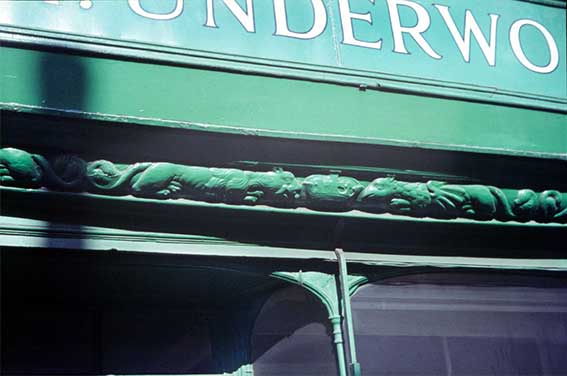 1960s
image courtesy Ipswich Society
1960s
image courtesy Ipswich Society

Above: a detail from the 'conserved' bressumer currently on the rear of
the replacement building. The paint layers removed, but also a part of
the beam around the tail of the creature to the left of the crown. The
crispness of the carving can now be appreciated. In the days when it
adorned the merchant's house, it would have been colourfully painted,
picking out details such as the blazon and royal crown.
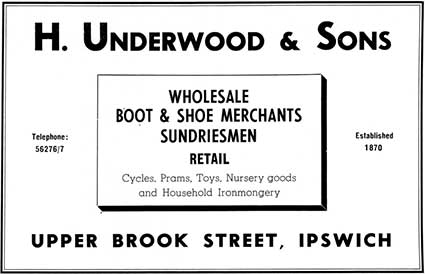 Advertisement 1965
Advertisement 1965
The comparative images below show the clearance of shops
for the
building of the Sainsbury
store on the west side of Upper Brook Street in the foreground. The
northern part of the Sainsbury store would have been the site of Sir
Thomas Rush's house. On the far left is the Ipswich Building Society
branch which is on the corner with Dogs Head Street. On the right is
the curved brick building which in 1934 replaced timber-framed
structures: 'Alexander Outfitters' on the illuminated hanging sign at
first floor level and the Avis Cook audio and television store in the
foreground (1-5 Tacket Street).
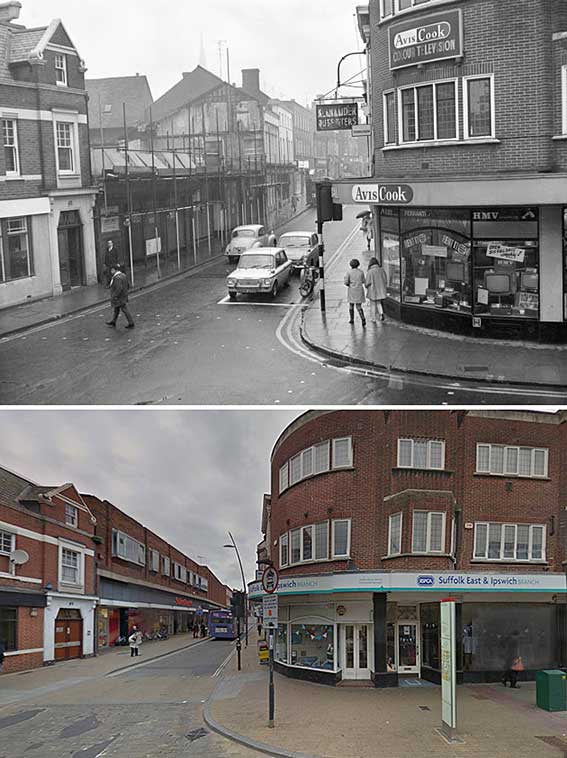
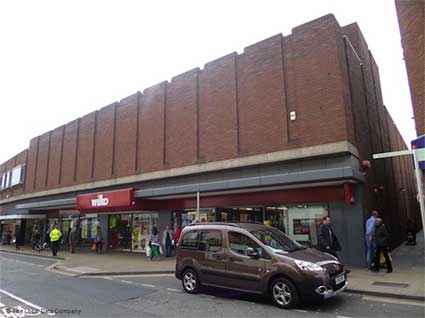
The present-day photograph shows the Wilkinson store with St Stephens
Church lane at the right and the beginning of the Sainsbury site at the
left.
Shop addresses in Lower Brook Street
in 2016 (it appears that the numbering of the properties in the
16th century varies from the postal addresses today):
Boreham Christopher Jewellers
26A Upper Brook St, Ipswich IP4 1EB
[St Stephens Church Lane]
Wilkinson store (formerly C&A)
28-32 Upper Brook St, Ipswich IP4 1EB
Sainsbury
38-40 Upper Brook St, Ipswich IP4 1EB
Kaspa’s (formerly Ipswich Building Society offices, formerly The Dog’s
Head In A Pot public house)
42-44 Upper Brook St, Ipswich IP4 1EB
28-32 would appear to indicate the width of Sir Thomas Rush’s house on
Lower Brook Street: the site currently occupied by Sainsbury’s (today
numbered 38-40). Scroll down this page to learn more about the complex
world of Thomas Rush and his remarkable survival as a politician at
Court.
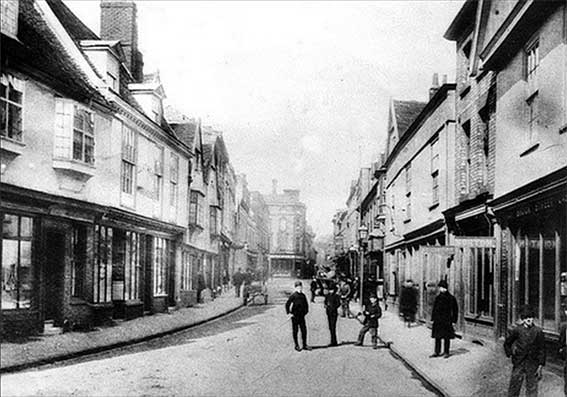 Photo
courtesy John Field
Photo
courtesy John Field
John Field sends this remarkable view of Upper Brook Street with
original timber-framed buildings in
situ. Symonds the chemist's shop
projects dramatically into the road north of the Butter Market
junction, leaving a narrow lane for traffic and pedestrians. This
photograph is clearly taken before road-widening, so pre-1900,
perhaps 1880-90. The shop which John believes was the home of Thomas
Rush is (probably) the one second from the left, with its two dormer
windows: Underwoods shop. It certainly bears a bressumer beam above the
shop-front and presumably it is the beam displayed close to the Church
of St Stephen, to the rear of these buildings. More research to come.
Incidentally, the Ipswich windows at the immediate left remind us just
how many fine – and once wealthy – houses were lost from this street.
Mansions in Ipswich
As a footnote, today's rather uninspiring urban
scene around the southern end of Upper Brook Street was
home to three wealthy, prestigious mansions belonging to powerful and
noble inhabitants.
1. The Duke of Suffolk
had a mansion in
Upper Brook Street, opposite that of Thomas
Rush (1487-1537), not as
we first thought on the site of the building at 39 Upper Brook Street
containing the archway leading to the old Woolworth car park (shown in
the photograph below painted pink and with a balustrade at roof level).
The
current building here was built by Charles Cullingham to act as his
Steam Brewery Tap for the Victorian brewery he built behind it. Both
were later taken over by Tollemache and renamed the Steam Brewery
Inn/Brewery Inn; it closed for business in 1920. The part to the north
of the archway has been empty and near-derelict for years; to the
south, the tiny bag shop Can-Can has operated successfully***.
The late Duke of Suffolk wouldn't recognise the place today. However, Charles Brandon, Duke of Suffolk
(c.1484-1545), is said to have
lived next door where the former Coach
and Horses Inn, 41 Upper Brook Street, still stands (whose coach houses
may have been the last
remaining
parts of the Duke's house), and adjoining the possible Brandon property
fronting Tacket Street. The Coach and Horses Inn operated as a coaching
inn from 1787 or earlier and closed for business in 1977. It is now
mainly a charity shop, but still bears the 'Winged Wheel' symbol of the
Cycling Tourist Club, as described on our Roundels
page. For a 1902 map of this area see our Symonds
for Kodaks page; it clearly shows an 'Inn' to the north and an
'Hotel' to the south of the entry.
[***UPDATE November 2018: The
Steam Brewery Tap/Tavern has, at long last, been modernised and rescued
from dilapidation, forming a retail shop fronting Upper Brook Street
with, presumably, separate accommodation behind. It's no longer pink.]
 2016 image
2016 image
2. The town house built by Sir Humphrey
Wingfield (c.1481-1545) of Brantham Hall, some four miles
south of the town on the Suffolk-Essex border. It
fronted Tacket
Street and is described on our Courts &
Yards
page in the section marked 'Tankard Street'.
3. Thomas Seckford's (1515-1587)
'Great
Place' in Westgate Street as described in our Lost Ipswich signs page under the section
'Before Willis'. Another perhaps surprising mansion –
more of a palace.
4. Hatton Court, off Tavern
Street, was the site of the home of Christopher Hatton (1540–1591) who
was born and lived in a fine White House, now replaced by an 18th
century house of timber, brick and plaster: the corner house (Listed
Grade II), now Church's Bistro with a wing at nos. 2 and 3 Hatton
Court (now part of McDonald's). He was considered a 'liberal patron of
learning and eminent for his piety, charity and integrity.' Sir
Christopher ingratiated himself, by his elegant and graceful dancing,
into the favour of Queen Elizabeth I and became Lord Chancellor in
1587. Which reminds us of that other Lord Chancellor from Ipswich,
Thomas Wolsey (c.1475-1530) who had his eye on...
5. The town house of Robert styled
'Lord' Curson (c.1460-1534/5) on St Peters Street, described on
our Curson Lodge and Wolsey's College pages.
6. Stoke Hall, next to St
Mary-At-Stoke, Church was built by the wine merchant Thomas Cartwright in 1744/5 and was
later occupied by the engineering entrepreneur, Robert James Ransome
(1830-1891).
7. The wealthy merchants of the town
would want a central, prestigious
house as they gained great riches. Henry
Tooley, William Smart, Robert Felaw, Richard
Purplett and others would be amongst them. It would only be in the
19th century that, to escape the overcrowding and pollution, the
wealthy would seek to build their houses in the leafier surrounding
areas (see, for example Upland Gate).
All this is a testament to the social, political and economic
significance of Ipswich throughout history and particularly in the 15th
and 16th centuries.
Our Roundels page repeats the above
photograph with others of this location with further commentary.
The Conservative Club, St Stephens Church Lane

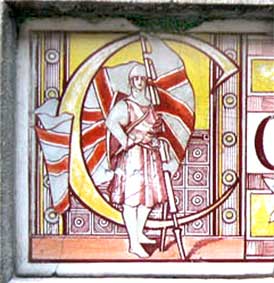 2014
images
2014
images
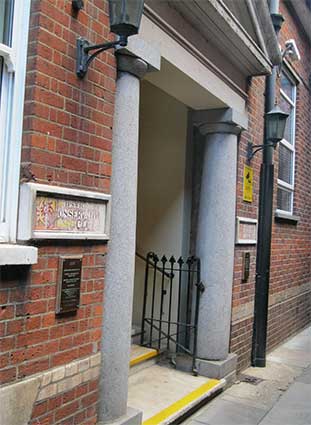 2018 image
2018 image
We had dismissed this lettering for many years, perhaps
because of politics, perhaps because it has always looked worn and run
down. However, in updating the St Stephens Church section (above), we
passed it again and decided it ought after all to be included. The left
panel is in rather poorer nick than the right, perhaps due to vandalism
(it doesn't say much for the quality of the ceramic tiles which make up
the signs), but the figure of the crusader bearing the huge Union Flag
banner is unmistakable. The yellow has worn better than the blue, it
must be said. The entrance to:
'IPSWICH
CONSERVATIVE
CLUB'
is in a narrow passageway leading from the church to
Upper Brook Street called St Stephen's Church
Lane. This is distinct from St Stephen's Lane which leads up from Dog's
Head Street, past The Sun Inn and
–
after Arras Square – runs up alongside The
Ancient House to come out opposite Dial
Lane. See our Soane Street page for a
note from Dr James Bettley regarding the Freemasons' move from this
building in St Stephens Church Lane to the new Freemasons' Hall near
Christchurch Mansion.
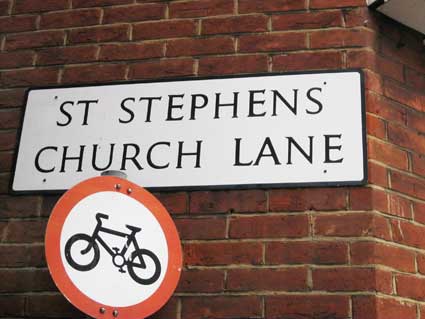 The metal
street sign at the Upper Brook Street end
The metal
street sign at the Upper Brook Street end
At a later visit we noticed some lettering on the wall adjacent
to The Conservative Club and towards St Stephen's Church (close to the
Con Club "smoker's ghetto"):
'E.L.D.
C.H.D.'
with
a stone block set into the wall above it, resembling a boundary
marker(?). See our gallery of Boundary
markers for information and images. What do the initials stand for?
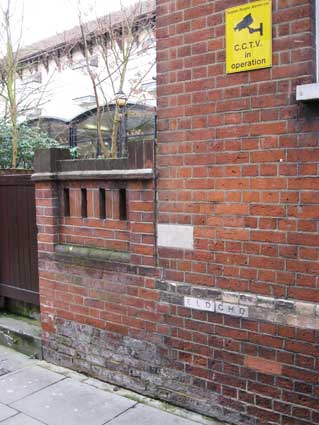
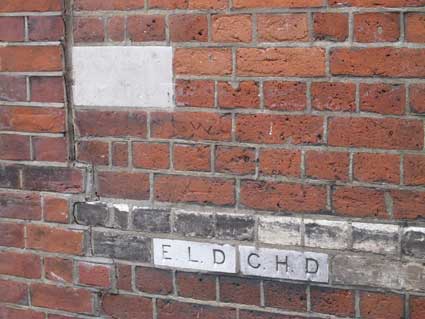 2014 images
2014 images
Now that we know that this building was the original home of the
Freemasons, perhaps this has a bearing on the initials. We assume that
they relate to Worshipful Masters or Grand Viziers of the day. This
original
Masonic Hall is the design of E.I. Bell (the only work by this
architect in Ipswich, we think) in 1865. To confirm the Masonic
connection, at the eastern end of the building is an external apse (an
arc of a circle in plan) shown below; this appears to be a convention
for Masonic Lodges, providing an 'altar' feature in the main meeting
hall(s). A similar feature can be seen on our Soane
Street page, along with the original foundation plaque for this
earlier Lodge.
 2018 image
2018 image
An unprepossessing set of palings hides bins and other clutter, but the
apse is clearly visible. A few yards from here is The
Sun Inn, reputed to have been commissioned to be built as a Masonic
Hall in the 17th century.
Another one bites the dust... 26 Upper Brook Street
[UPDATE 25.3.25: 'I may be a
bit late to the party but I've just spotted this old Thomas Cook
signage on Upper Brook Street next to St Stephens Church Lane. Premises
had been used by Cancer Research since at least 2009. Ed Broom'. Thanks to Ed for spotting this curiously
'negative-space' shop sign (photographer and bicycle shown in
reflection). Presumably a contractor took the trouble to knock out the
plastic characters of the shop sign. Having been founded in 1841 and
becoming one of the most familiar names in holiday travel, the Thomas
Cook Group went into liquidation in 2019.]
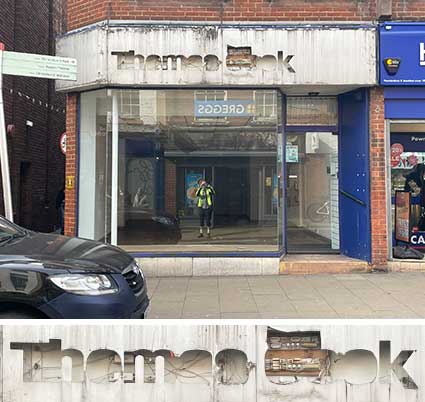 2025
image
2025
image
The complex world of Thomas Rush and
his son-in-law, Thomas Alvard (taken from the MacCulloch &
Blatchly paper – cited above, under the heading "Sir
Thomas Rush's house")
'The genealogy of the Alvards and Rushes is complicated enough, but
once one starts examining their affairs, a picture of equal complexity
emerges, of connections administrative, commercial and official, among
layman and cleric, amid town and country. If Anne Rivers' first two
husbands had careers which were conventional enough, Thomas Rush's was
of quite a different sort. His pedigree's significant silence about his
origins indicates that they were obscure; he probably came from
Lincolnshire, for his career was founded on his service to the
Lincolnshire and Suffolk aristocratic family of the Lords Willoughby of
Eresby, who brought several Lincolnshire families to live in south-east
Suffolk. He was among Christopher Lord Willoughby's servants when
Willoughby made his will in 1499, and he would be William Lord
Willoughby's executor in 1526; he made his home at Sudbourne near the
Willoughbys' Suffolk headquarters at Orford, and had much to do with
the nearby monastery at Butley, which had strong Willoughby
connections.' It was probably through his influence that his
brother-in-law Augustine Rivers moved from being Prior of Woodbridge to
become Prior of Butley (a much larger Augustinian house) in 1509; Rush
and his son-in-law the younger Thomas Alvard would remain close
associates of Rivers' successor, the Sudbourne boy Thomas Manning, last
Prior of Butley. Rush was steward of both Woodbridge and Butley
Priories in 1535.
Quite early in his career, however, Rush's Willoughby links seem also
to have given him an entrée into royal service. He was already
described as the King's servant in 1508, when he was made
Serjeant-at-Arms; in 1513 he was seeing service in the first of Henry
VIII's absurd French military adventures, and he would continue to
serve in the wars. From 1517 he was enjoying a shilling a day from the
Crown for life. He was made a Knight of the Sword at Anne Boleyn's
coronation in 1533. It was probably his familiarity with the Court
which introduced his stepson and son-in-law Thomas Alvard to the
service of Cardinal Wolsey, perhaps appealing to the belated sense of
affection for his home town which the Cardinal discovered after his
visit of 1517; the Wolsey connection brought them an invaluable future
investment in the shape of the friendship of Wolsey's servant Thomas
Cromwell. When Wolsey's credit collapsed in 1528-9, Alvard and Cromwell
would hasten into the King's service, and they would continue to have a
fruitful relationship; Alvard and Rush, with their friend Prior Manning
of Butley, would be Cromwell's most valuable contacts in Suffolk during
the 1530s.
The way in which Rush and Alvard followed Cromwell into the royal
service is neatly illustrated by their involvement in both the creation
and the destruction of Cardinal College,
Ipswich. Rush served as attorney for the College with William Bamburgh
(his nephew and Alvard's brother-in-law), and he was naturally
prominent among those giving presents to the College on its opening in
1528; equally naturally he was the recipient of College leases.
However, when Wolsey's crash came and the lands of his foundation were
dispersed to suit the King, Rush and Alvard could offer the royal
administration their inside knowledge of Wolsey's affairs in
supervising the carve-up, and could also do themselves a good turn in
picking up some of the spoils; Rush was on the county commission to
enquire into Wolsey's late lands in 1530, and both he and Alvard did
well out of the Crown leases in this property. Why not? It was too late
to save the College, and their old master ,the Cardinal, was past
harming.
Why did Rush decide to make an alliance with the Ipswich Alvards rather
than among the Suffolk county gentry? Perhaps his Lincolnshire origins
and their obscurity meant that he was not acceptable in county society,
and so he chose to make his way into the very separate world of the
merchants of Ipswich; in the event, both his wives would be the widows
of wealthy Ipswich merchants. His marriage to Anne Rivers meant that he
inherited the elder Alvard's capital messuage in St Stephen's parish,
to which in 1518 he added a garden of the parsonage leased from Thomas
Paccarde the incumbent. It would be natural for him to mark his
steadily more successful career by building on Alvard's foundation of a
temporary four-year chantry service in the church to create a family
aisle fit for the dignity of a Knight of the Sword. It is worth noting
that he handed over the office of Customer at Ipswich to his associate
John Valentine (another Wolsey servant) in 1528; presumably by this
time he felt that such a local commercial association was not
appropriate to his status.
By this time, of course, Rush was fully integrated into the county
elite outside the town of Ipswich, havingbecome a county J.P.
sometimebetween1520 and 1524; his son joined him on the Bench in 1534 —
a mark of the family's unusual status, for the Crown was normally
reluctant to allow father and son to sit together as justices. This was
a mark of Cromwell's high trust that the Rushes would serve his and the
King's purpose in the county. By now family marriages were beginning to
reflect this enhanced status: matches were arranged with Suffolk gentry
families with Court links like those of the Rushes themselves, bringing
in daughters of Sir Anthony Wingfield and the Duke of Suffolk's servant
Nicholas Cutler.
The younger Alvard and Rush were both buried in St Stephen's; Rush's
will is lost, but Alvard in his requested a marble stone showing his
arms in the church. No doubt the monuments of the Rush and Alvard
families were of the highest quality as befitted wealthy and powerful
people. That Anne Rivers had a second memorial is indicated by the
fifth coat of arms noted by William Tillotson in the church c. 1594. Of
ten coats, the relevant ones are 4 Alvard; 5 Rush impaling Rivers; 7
Alvard; 9 Alvard impaling two coats: Rush and Darcy. The ninth coat
will presumably have been on Alvard's marble stone; he must have
married a Darcy before predeceasing Rush in 1535.
Although Rush seems to have been buried in the aisle which he had so
lavishly created, there is no surviving evidence of a memorial for him.
This may be because his eldest son Arthur died only a month after him
in July 1537 and left a son and heir who can have been little more than
a baby; Thomas Cromwell was Sir Thomas's chief executor, and it is
likely that the political excitements of the next three years,
culminating in his own fall and execution in 1540, distracted him from
providing a monument. It may have been in the confusion of his fall
that Rush's will disappeared from his papers; there is no evidence of
probate. William Bamburgh of Rendlesham, one of the other executors and
another old Willoughby servant from Lincolnshire, was preoccupied with
disputes over the earlier will of the younger Thomas Alvard (his
brother-in-law), and he also became entangled in a dispute with Sir
Thomas's grandson, Anthony, over the administration of Sir Thomas's
goods which dragged on as late as 1561, resulting in Bamburgh losing
the administration. Meanwhile Sir Thomas's second wife, Christian, was
caught up in the years after his death with her own set of testamentary
disputes over the will of her first husband, the Ipswich bailiff and
M.P. Thomas Baldry; in any case she may not have taken much interest in
a chapel associated with Sir Thomas's first wife Anne. With such a
combination of mishaps, it is hardly surprising that the Rush chapel at
St Stephen's seems like an enterprise still-born. No later members of
the family appear to have taken any interest in it.
Nevertheless, what had been erected in the Rush Chapel probably
remained in a reasonable state up to the Civil War (1642–1651).
Tillotson was able to note the heraldry of the monuments in the 1590s;
Blois saw the main Alvard stone apparently intact on his visit, but in
October 1657 Candler recorded sadly that 'the brasse hath been taken of
from all the old monuments for lucre thereof in the times of the late
unhappy warres'. His phrase seems specific enough to suggest that the
brasses were removed for money before the visit of William Dowsing*, a
supposition strengthened by the fact that Dowsing found only one
'popish inscription in Brass, pray for the Soul', on his visit on 30
January 1644. The Alvard — Rivers — Wimbill matrix remained to be drawn
by Davy in August 1829, so its burial must have taken place during the
last century restorations. It lay in 1829 where it was found buried in
1985, near the centre of the western bay of the chapel. Today, this
slab and the single Lombardic letter T on the external aisle buttress
are the only remains to testify to this mausoleum of a remarkable trio
of men of affairs, their much-married spouses and their uniquely
labyrinthine genealogies.'
[*William Dowsing (1596–1668)
was an English iconoclast who operated at the time of the English Civil
War. Dowsing was a puritan soldier who was born in Laxfield, Suffolk.
In 1643 he was appointed by their captain-general, the Earl of
Manchester, as 'Commissioner for the destruction of monuments of
idolatry and superstition' to carry out a Parliamentary Ordinance of 28
August 1643 which stated that 'all Monuments of Superstition and
Idolatry should be removed and abolished', specifying: 'fixed altars,
altar rails, chancel steps, crucifixes, crosses, images of the Virgin
Mary and pictures of saints or superstitious inscriptions.' In May 1644
the scope of the ordinance was widened to include representations of
angels (a particular obsession of Dowsing's), rood lofts, holy water
stoups, and images in stone, wood and glass and on plate.
Dowsing carried out his work in 1643–44 by visiting over 250 churches
in Cambridgeshire and Suffolk, removing or defacing items that he
thought fitted the requirements outlined in the ordinance. He recruited
assistants, apparently among his friends and family, and where they
were unable to perform the work themselves he left instructions for the
work to be carried out. Sometimes the local inhabitants assisted his
work, but often he was met by resistance or non-co-operation. His
commission, backed up by the ability to call on military force if
necessary, meant that he usually got his way. He charged each church a
noble (a third of a pound) for his services.
When Manchester, his patron, fell out with Oliver Cromwell in late
1644, his commission ceased. Dowsing is unique amongst those who
committed iconoclasm during this period because he left a journal
recording much of what he did, with many detailed entries.]
Home
Please email any comments and contributions by clicking here.
Search Ipswich
Historic Lettering
©2004 Copyright
throughout the Ipswich
Historic Lettering site: Borin Van Loon
No reproduction of text or images without express written permission
 2015 aerial view
2015 aerial view


 2014 images
2014 images 
 2014 images
2014 images
 2016 images
2016 images




 2016 images
2016 images



 Composite
2016 photograph of the buttress
Composite
2016 photograph of the buttress



 2020
images
2020
images
 2021
images
2021
images 1674 view
1674 view 1674 map
1674 map 2015 aerial view
2015 aerial view
 Courtesy Ipswich Society Image Archive
Courtesy Ipswich Society Image Archive 1960s
image courtesy Ipswich Society
1960s
image courtesy Ipswich Society
 Advertisement 1965
Advertisement 1965

 Photo
courtesy John Field
Photo
courtesy John Field 2016 image
2016 image
 2014
images
2014
images 2018 image
2018 image The metal
street sign at the Upper Brook Street end
The metal
street sign at the Upper Brook Street end
 2014 images
2014 images 2018 image
2018 image 2025
image
2025
image